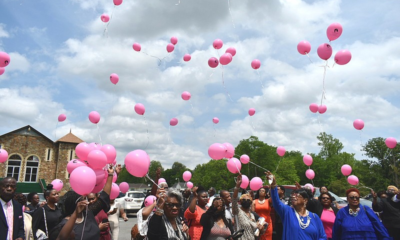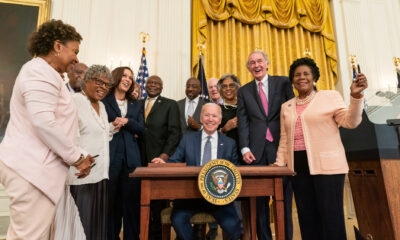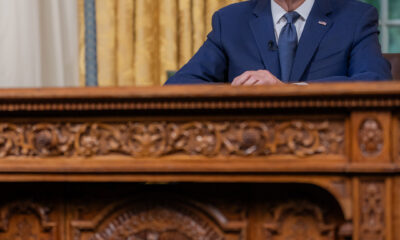Featured
Gathering in Grace: Leaders of Catholic Religious Orders Meet to Grapple with Order from Rome

The estimates of African-American women who belong to Catholic Religious orders vary, but black nuns in the U.S. certainly number in the hundreds. Among them is Sister Roberta Fulton, of the Sisters of St. Mary of Namur.

Sister Roberta Fulton, SSMN, of Buffalo, is the president of the National Black Sisters Conference. The LCWR assembly in St. Louis drew about 900 leaders of Catholic religious orders, Aug. 7-11.
Fulton, who is also president of the National Black Sisters Conference, was among the 900 women who attended the Leadership Conference of Women Religious (LCWR) Assembly in St. Louis August 7-10.
Based in Buffalo, Fulton arrived at the assembly buoyed by a sense of support from fellow African-American Catholics about the issue of the hour: the mandate.
“We just had our big National Black Catholics Congress (NBCC) in Indiana and many of the people there were aware and want to give their support to us,” said Fulton, who also serves on the NBCC’s board of trustees.
Word from the Vatican
The mandate arrived on April 18: a demand that the LCWR place itself under the direction of Seattle Archbishop J. Peter Sartain and two other bishops.
The message was clear: the nation’s largest group of sisters who lead Catholic religious orders would have to get in line with church teachings on several issues. The 1,500-member LCWR is made up of superiors of 320 religious orders that represent 80 percent of the sisters in this country.
Among the sisters who felt injured by the mandate was Sister Mary Waskowiak of Burlingame, Calif.
“I had a lot of anger last April 18,” she said. “It’s a public humiliation. We have made our vows to God within a church. We are believers in a shared community.”
Sister Donna Markham of Cincinnati had similar feelings on April 18.
“I felt extremely hurt, betrayed by my own church.”

LCWR members answer questions from the media. From left, Sister Mary Waskowiak, RSM; Sister Mary Pellegrino, CSJ; Sister Donna Markham, OP; and Sister Annmarie Sanders, IHM
Areas of contention
As the National Catholic Reporter reported on April 18, the Vatican’s Congregation for the Doctrine of the Faith ordered the LCWR to reform its statutes, programs and affiliations to conform more closely to “the teachings and discipline of the Church.”
The Vatican began scrutinizing the LCWR in 2009 when it launched an investigation, called a “doctrinal assessment,” to review what it called “quality of life” in U.S. religious orders. One issue raised was the shrinking ranks of nuns, which the LCWR addressed on the third day of its assembly.
The key said, Sister Nancy Schreck of Dubuque, Iowa, is collaboration and thinking globally in challenging times for recruitment for a variety of religions.
When it comes to African-American nuns, a 2001 estimate put the number at about 500. In 2009 that figure dropped to about 300.
“We desire to be inclusive communities, said Schreck. “That means internal conversation, dealing with our own prejudices and cultures. But the desire is there. We’re always trying to discern together how we can move into the future.”
Beyond the issue of dwindling numbers, according to a letter to LCWR from the Congregation for the Doctrine of the Faith, the Vatican also takes issue with the LCWR’s in three areas:
- The content of speakers’ addresses at the annual LCWR assemblies, including “manifest problematic statements and serious theological, even doctrinal errors.”
- “Corporate dissent” in the congregation regarding the church’s sexual teachings, like “protesting the Holy See’s actions regarding the question of women’s ordination and of a correct pastoral approach to ministry to homosexual persons”
- “A prevalence of certain radical feminist themes incompatible with the Catholic faith” present in some of the organizations programs and presentations, “ including theological interpretations that risk distorting faith in Jesus and his loving Father who sent his Son for the salvation of the world.”
In a National Public Radio interview on Fresh Air on July 17, LCWR president Sister Pat Farrell said the group could comply with the mandate, not comply and break away from the church, or seek a way “that refuses to just define the mandate and the issues in such black-and-white terms.”
Sisters at the assembly in St. Louis seemed to seek a measured approach.
“A lot of it is meeting to collaborate (with the bishops), to see that we are on the same page in lots of ways, wanting to be out there preaching the gospel and bringing the message of Christ to all of those people that we work with,” said Fulton.
“The mandate is the mandate,” said Sister Mary Pellegrino of Baden, Penn. “We need to figure out how we are going to get through this together in a way that’s respectful.”
“What we hope for is not a clear option, or an avenue for action. We are asking God to show us together the next best step,” said Waskowiak.
“Sometimes God’s call leads us to the foot of the cross,” said Markham. “We can’t risk splitting our church.”
On the third full day of the assembly, sisters speaking at press conference said it was unlikely the LCWR leadership would take any action about the mandate in St. Louis, but first review input from attendees and fellow religious around the country.

St. Alphonsus Liguori "ROCK" Catholic Church in St. Louis. Research shows that only about three million Americans identify themselves as black and Catholic.
Like Fulton, many sisters at the LCWR assembly said they felt encouraged by support for their cause among their communities and congregations.
“I think sometimes you think you are out there on the edge by yourself but when you find that support,” Fulton said.
Chicago resident Christine Harrell, 28, said nuns “give Catholicism a good name.”
Harrell, who describes herself as biracial, is a writer and teacher who used to attend a Catholic church but now worships with a Unitarian Universalist congregation.
“My sense is that ever since Ratzinger became Pope, the Church has been on a purity kick of some kind,” Harrell said. “It’s like the Vatican is trying to keep the Church extra Catholic, weeding out anything that isn’t Catholic enough by their standards. So now they want three bishops to oversee (the LCWR), an organization which, to me, is run very democratically for a Catholic organization.”
Following news coverage of the gathering, Ruth Jones, 80, said she’s inclined to give nuns the benefit of her support.
“Watching the sisters on the news, I have to believe they have a point.”
Jones attends predominantly African-American St. Alphonsus Liguori “ROCK” Catholic Church in St. Louis. She taught alongside nuns at local Catholic schools in the 1960s and 1970s and counts many as her “buddies.”
“The sisters are the backbone of the Church,” said Jones. “Sometimes men in the upper echelons don’t want women to speak.”
On the second day of the assembly the editor the National Catholic Reporter was unequivocal in his support for the LCWR.
“I do really feel your pain. And I feel the hurt. And I feel the humiliation. At the same time I sense your uniquely profound joy and determination and courage,” Tom Fox said. “There is no question about who you are and how you will come out of this.”
Another speaker, Sister Jennifer Gordon of Leavenworth, Kan., urged those gathered to keep their work in sight during a difficult time.
“We must continue taking the risk to go to the edge. We have a call to follow Jesus to the margins, to love deeply those we meet there,” Gordon said. “In times as unsettling as these it is tempting to take a step back, to retreat to the comfortable or at least the familiar.”

The LCWR assembly in St. Louis included a exhibitor hall for items for sale. These are from Earth Rhythms by the Sisters of Charity of Leavenworth, Kan.
Both Fox’s and Gordon’s remarks seemed to speak directly to what some call the Vatican’s attempts to keep nuns “in their place.”
“Continue to go to the core of your pastoral history and preach it will all your might. This is what gives us hope,” Fox said.
“You must interpret these turbulent times in our church and world and guide us to the edge,” Gordon said. “Nudge us please toward that edge, challenge us to be our very best selves and call us to that margin of grace.”
Black Catholics today
About 24 percent of all Americans identify themselves as Catholic. Among African-Americans the percentage is much lower. According to a CARA Catholic poll, just 3 percent of American Catholics, or three million Americans, identify themselves as both black and Catholic.
Still, the National Black Catholic Survey released in 2011 found that on average African-Americans are more religiously engaged than their white Catholic counterparts.
The role of sisters in communities—as teachers, counselors, and social service providers–is likely a factor in this, said Fulton, and may be why Catholics from a variety of backgrounds are supporting the LCWR over the Vatican mandate.
“You find people who really see the goodness that we’ve done and see the dedication, see how committed we are to not only ministry, but our way of life,” she said.
On the last full day of the assembly, Farrell made a remark that may also resonate with African-American Catholics. Asked by reporter what the LCWR wants out of its dialogue with the bishops, she answered:
“I think what we want is to finally, at some end stage of the process, to be recognized and understood as equal in the church, that our form of religious life can be respected and affirmed.”
Learn More
- The Leadership Conference of Women Religious
- Congregation for the Doctrine of the Faith (Wikipedia)
- “Study: Black Catholics are More Engaged” (National Catholic Reporter)
- “Dwindling Numbers, Constant Faith; Mostly Black Order of Nuns in Harlem Celebrates 85 Years” (New York Times)
- “The Real ‘Sister Act’: Black Nuns in America” (TheGrio.com)
- Black Catholic Congress Develops Five-Year Plan

-

 Featured12 months ago
Featured12 months agoCalifornia Is the First State to Create A Public Alert for Missing Black Youth
-

 Featured11 months ago
Featured11 months agoAfrican American Leaders Stay the Course Amid Calls for President Biden To Bow Out of Race
-

 Featured12 months ago
Featured12 months agoThe Debate Fallout Lands on Both Candidates
-

 Featured11 months ago
Featured11 months agoPresident Joe Biden Decides to Withdraw from the Presidential Race
-

 Featured11 months ago
Featured11 months agoPresident Joe Biden Describes Shooting of Donald Trump As ‘Sick’
-

 Featured11 months ago
Featured11 months agoIn One of His Final Speeches as President, Biden Says It’s Time for ‘Fresh Voices’

